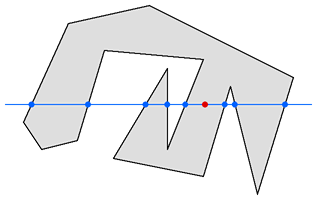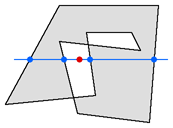如何判断一个点在不规则多边形内部
2013-11-25 14:59
465 查看
原文: http://alienryderflex.com/polygon/
Point-In-Polygon Algorithm — Determining Whether A Point Is Inside A Complex Polygon
Visit the new
page which adds spline curves to this technique! Also visit the shortest-path-through-polygon page!

Figure
1
Figure 1 demonstrates a typical case of a severely concave polygon with 14 sides. The red dot is a point which needs to be tested, to determine if it lies
inside the polygon.
The solution is to compare each side of the polygon to the Y (vertical) coordinate of the test point, and compile a list of nodes,
where each node is a point where one side crosses the Y threshold of the test point. In this example, eight sides of the polygon cross the Y threshold, while the other six sides do not. Then, if there are an odd number
of nodes on each side of the test point, then it is inside the polygon; if there are an even number
of nodes on each side of the test point, then it is outside the polygon. In our example, there are five nodes to the left of the test point, and three nodes to the right. Since five and three are odd numbers, our test point is inside the polygon.
(Note: This algorithm does not care whether the polygon is traced in clockwise or counterclockwise fashion.)

Figure
2
Figure 2 shows what happens if the polygon crosses itself. In this example, a ten-sided polygon has lines which cross each other. The effect is much like
“exclusive or,” or XOR as it is known to assembly-language programmers. The portions of the polygon which overlap cancel each other out. So, the test point is outside the polygon, as indicated by the even number of nodes (two and two) on either side of it.

Figure
3
In Figure 3, the six-sided polygon does not overlap itself, but it does have lines that cross. This is not a problem; the algorithm still works fine.

Figure
4
Figure 4 demonstrates the problem that results when a vertex of the polygon falls directly on the Y threshold. Since sides a and b both
touch the threshold, should they both generate a node? No, because then there would be two nodes on each side of the test point and so the test would say it was outside of the polygon, when it clearly is not!
The solution to this situation is simple. Points which are exactly on the Y threshold must be considered to belong to one side of the threshold. Let’s say
we arbitrarily decide that points on the Y threshold will belong to the “above” side of the threshold. Then, side a generates
a node, since it has one endpoint below the threshold and its other endpoint on-or-above the threshold. Side bdoes
not generate a node, because both of its endpoints are on-or-above the threshold, so it is not considered to be a threshold-crossing side.

Figure
5
Figure 5 shows the case of a polygon in which one of its sides lies entirely on the threshold. Simply follow the rule as described concerning Figure 4.
Side c generates a node, because it
has one endpoint below the threshold, and its other endpoint on-or-above the threshold. Side d does
not generate a node, because it has both endpoints on-or-above the threshold. And side e also
does not generate a node, because it has both endpoints on-or-above the threshold.

Figure
6
Figure 6 illustrates a special case brought to my attention by John David Munch of Cal Poly. One interior angle of the polygon just touches the Y-threshold
of the test point. This is OK. In the upper picture, only one side (hilited in red) generates a node to the left of the test point, and in the bottom example, three sides do. Either way, the number is odd, and the test point will be deemed inside the polygon.
Polygon Edge
If the test point is on the border of the polygon, this algorithm will deliver unpredictable results; i.e. the result may be “inside” or “outside” depending
on arbitrary factors such as how the polygon is oriented with respect to the coordinate system. (That is not generally a problem, since the edge of the polygon is infinitely thin anyway, and points that fall right on the edge can go either way without hurting
the look of the polygon.)
C Code Sample
Here’s an efficiency improvement provided by Nathan Mercer. The blue code eliminates calculations on sides that are entirely to the right of the test point.
Though this might be occasionally slower for some polygons, it is probably faster for most.
Here’s another efficiency improvement provided by Lascha Lagidse. The inner “if” statement is eliminated and replaced with an exclusive-OR operation.
And here’s a pre-calcuation efficiency improvement provided by Patrick Mullen. This is useful if you have many points that need to be tested against the
same (static) polygon:
Integer Issue
What if you’re trying to make a polygon like the blue one below (Figure 7), but it comes out all horizontal and vertical lines, like the red one? That indicates
that you have defined some of your variables as integers instead of floating-point. Check your code carefully to ensure that your test point and all the corners of your polygon are defined as, and passed as, floating-point numbers.

Figure
7
Point-In-Polygon Algorithm — Determining Whether A Point Is Inside A Complex Polygon
Visit the new
page which adds spline curves to this technique! Also visit the shortest-path-through-polygon page!

Figure
1
Figure 1 demonstrates a typical case of a severely concave polygon with 14 sides. The red dot is a point which needs to be tested, to determine if it lies
inside the polygon.
The solution is to compare each side of the polygon to the Y (vertical) coordinate of the test point, and compile a list of nodes,
where each node is a point where one side crosses the Y threshold of the test point. In this example, eight sides of the polygon cross the Y threshold, while the other six sides do not. Then, if there are an odd number
of nodes on each side of the test point, then it is inside the polygon; if there are an even number
of nodes on each side of the test point, then it is outside the polygon. In our example, there are five nodes to the left of the test point, and three nodes to the right. Since five and three are odd numbers, our test point is inside the polygon.
(Note: This algorithm does not care whether the polygon is traced in clockwise or counterclockwise fashion.)

Figure
2
Figure 2 shows what happens if the polygon crosses itself. In this example, a ten-sided polygon has lines which cross each other. The effect is much like
“exclusive or,” or XOR as it is known to assembly-language programmers. The portions of the polygon which overlap cancel each other out. So, the test point is outside the polygon, as indicated by the even number of nodes (two and two) on either side of it.

Figure
3
In Figure 3, the six-sided polygon does not overlap itself, but it does have lines that cross. This is not a problem; the algorithm still works fine.

Figure
4
Figure 4 demonstrates the problem that results when a vertex of the polygon falls directly on the Y threshold. Since sides a and b both
touch the threshold, should they both generate a node? No, because then there would be two nodes on each side of the test point and so the test would say it was outside of the polygon, when it clearly is not!
The solution to this situation is simple. Points which are exactly on the Y threshold must be considered to belong to one side of the threshold. Let’s say
we arbitrarily decide that points on the Y threshold will belong to the “above” side of the threshold. Then, side a generates
a node, since it has one endpoint below the threshold and its other endpoint on-or-above the threshold. Side bdoes
not generate a node, because both of its endpoints are on-or-above the threshold, so it is not considered to be a threshold-crossing side.

Figure
5
Figure 5 shows the case of a polygon in which one of its sides lies entirely on the threshold. Simply follow the rule as described concerning Figure 4.
Side c generates a node, because it
has one endpoint below the threshold, and its other endpoint on-or-above the threshold. Side d does
not generate a node, because it has both endpoints on-or-above the threshold. And side e also
does not generate a node, because it has both endpoints on-or-above the threshold.

Figure
6
Figure 6 illustrates a special case brought to my attention by John David Munch of Cal Poly. One interior angle of the polygon just touches the Y-threshold
of the test point. This is OK. In the upper picture, only one side (hilited in red) generates a node to the left of the test point, and in the bottom example, three sides do. Either way, the number is odd, and the test point will be deemed inside the polygon.
Polygon Edge
If the test point is on the border of the polygon, this algorithm will deliver unpredictable results; i.e. the result may be “inside” or “outside” depending
on arbitrary factors such as how the polygon is oriented with respect to the coordinate system. (That is not generally a problem, since the edge of the polygon is infinitely thin anyway, and points that fall right on the edge can go either way without hurting
the look of the polygon.)
C Code Sample
// Globals which should be set before calling this function:
//
// int polySides = how many corners the polygon has
// float polyX[] = horizontal coordinates of corners
// float polyY[] = vertical coordinates of corners
// float x, y = point to be tested
//
// (Globals are used in this example for purposes of speed. Change as
// desired.)
//
// The function will return YES if the point x,y is inside the polygon, or
// NO if it is not. If the point is exactly on the edge of the polygon,
// then the function may return YES or NO.
//
// Note that division by zero is avoided because the division is protected
// by the "if" clause which surrounds it.
bool pointInPolygon() {
int i, j=polySides-1 ;
bool oddNodes=NO ;
for (i=0; i<polySides; i++) {
if (polyY[i]<y && polyY[j]>=y
|| polyY[j]<y && polyY[i]>=y) {
if (polyX[i]+(y-polyY[i])/(polyY[j]-polyY[i])*(polyX[j]-polyX[i])<x) {
oddNodes=!oddNodes; }}
j=i; }
return oddNodes; } |
Though this might be occasionally slower for some polygons, it is probably faster for most.
// Globals which should be set before calling this function:
//
// int polySides = how many corners the polygon has
// float polyX[] = horizontal coordinates of corners
// float polyY[] = vertical coordinates of corners
// float x, y = point to be tested
//
// (Globals are used in this example for purposes of speed. Change as
// desired.)
//
// The function will return YES if the point x,y is inside the polygon, or
// NO if it is not. If the point is exactly on the edge of the polygon,
// then the function may return YES or NO.
//
// Note that division by zero is avoided because the division is protected
// by the "if" clause which surrounds it.
bool pointInPolygon() {
int i, j=polySides-1 ;
bool oddNodes=NO ;
for (i=0; i<polySides; i++) {
if ((polyY[i]< y && polyY[j]>=y
|| polyY[j]< y && polyY[i]>=y)
&& (polyX[i]<=x || polyX[j]<=x)) {
if (polyX[i]+(y-polyY[i])/(polyY[j]-polyY[i])*(polyX[j]-polyX[i])<x) {
oddNodes=!oddNodes; }}
j=i; }
return oddNodes; } |
// Globals which should be set before calling this function:
//
// int polySides = how many corners the polygon has
// float polyX[] = horizontal coordinates of corners
// float polyY[] = vertical coordinates of corners
// float x, y = point to be tested
//
// (Globals are used in this example for purposes of speed. Change as
// desired.)
//
// The function will return YES if the point x,y is inside the polygon, or
// NO if it is not. If the point is exactly on the edge of the polygon,
// then the function may return YES or NO.
//
// Note that division by zero is avoided because the division is protected
// by the "if" clause which surrounds it.
bool pointInPolygon() {
int i, j=polySides-1 ;
bool oddNodes=NO ;
for (i=0; i<polySides; i++) {
if ((polyY[i]< y && polyY[j]>=y
|| polyY[j]< y && polyY[i]>=y)
&& (polyX[i]<=x || polyX[j]<=x)) {
oddNodes^=(polyX[i]+(y-polyY[i])/(polyY[j]-polyY[i])*(polyX[j]-polyX[i])<x); }
j=i; }
return oddNodes; } |
same (static) polygon:
// Globals which should be set before calling these functions:
//
// int polySides = how many corners the polygon has
// float polyX[] = horizontal coordinates of corners
// float polyY[] = vertical coordinates of corners
// float x, y = point to be tested
//
// The following global arrays should be allocated before calling these functions:
//
// float constant[] = storage for precalculated constants (same size as polyX)
// float multiple[] = storage for precalculated multipliers (same size as polyX)
//
// (Globals are used in this example for purposes of speed. Change as
// desired.)
//
// USAGE:
// Call precalc_values() to initialize the constant[] and multiple[] arrays,
// then call pointInPolygon(x, y) to determine if the point is in the polygon.
//
// The function will return YES if the point x,y is inside the polygon, or
// NO if it is not. If the point is exactly on the edge of the polygon,
// then the function may return YES or NO.
//
// Note that division by zero is avoided because the division is protected
// by the "if" clause which surrounds it.
void precalc_values() {
int i, j=polySides-1 ;
for(i=0; i<polySides; i++) {
if(polyY[j]==polyY[i]) {
constant[i]=polyX[i];
multiple[i]=0; }
else {
constant[i]=polyX[i]-(polyY[i]*polyX[j])/(polyY[j]-polyY[i])+(polyY[i]*polyX[i])/(polyY[j]-polyY[i]);
multiple[i]=(polyX[j]-polyX[i])/(polyY[j]-polyY[i]); }
j=i; }}
bool pointInPolygon() {
int i, j=polySides-1 ;
bool oddNodes=NO ;
for (i=0; i<polySides; i++) {
if ((polyY[i]< y && polyY[j]>=y
|| polyY[j]< y && polyY[i]>=y)) {
oddNodes^=(y*multiple[i]+constant[i]<x); }
j=i; }
return oddNodes; } |
What if you’re trying to make a polygon like the blue one below (Figure 7), but it comes out all horizontal and vertical lines, like the red one? That indicates
that you have defined some of your variables as integers instead of floating-point. Check your code carefully to ensure that your test point and all the corners of your polygon are defined as, and passed as, floating-point numbers.

Figure
7
相关文章推荐
- 如何判断一个点是否在一个多边形内部(有向面积)
- 如何判断一个点是否在一个多边形内部+三角形有向面积公式
- 判断一个坐标点是否在不规则多边形内部的算法
- c++中如何判断一个点在多边形内部
- 如何判断一个点是否在一个多边形内部
- 如何判断一个点是否在多边形内部还是外部
- 如何判断一个点是否在一个多边形内部(转)
- 判断一个坐标点是否在不规则多边形内部的算法
- openlayers2 开发如何判断一个marker所在的点是否在一个多边形内部
- 如何判断一个点是否在多边形内部?
- 如何判断一个点是否在多边形内部ne?
- 判断一个坐标点是否在不规则多边形内部的算法
- [转]如何判断一个点是否在一个多边形内部
- 如何判断一个指定的经纬度点是否落在一个多边形内
- 给定一个多边形的形状点列如何判断顺时针还是逆时针
- 如何判断一个指定的经纬度点是否落在一个多边形区域内?
- Matlab如何判断一个点是否落在一个不规则的封闭区域中
- 在Android里如何判断一个指定的经纬度点是否落在一个多边形区域内
- 判断一个点是否在多边形内部 [2] 射线法实现
- 判断一个点是否在多边形内部 - 射线法思路
